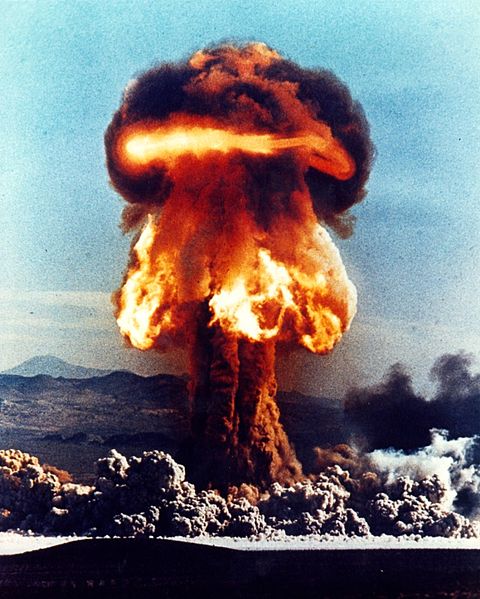Terrorism in itself is disturbing and feared in the modern world. Throughout the evolution of terrorism, many tactical innovations have been made by terrorist organizations to complete their goals more effectively. In recent years, terrorist organizations have shown interest in using weapons of mass destruction to incite fear in their adversaries, but the validity of this threat is not fully understood.
In order to understand the magnitude of the threat of WMD terrorism, it is imperative to first look at what weapons of mass destruction are. Generally, weapons of mass destruction consist of chemical, biological, and nuclear weapons. The escalating violence used in terrorist attacks, like al Qaeda’s use of explosives and suicide bombs to carry out their goals, clearly show that extremists are increasingly willing to use more unconventional means. It is difficult to imagine more drastic means of terrorism than the use of high powered explosives; however, WMDs clearly fit the description. Whether it is chemical, biological, or nuclear, WMDs have the ability to affect large numbers of people at a varying cost to the perpetrators.
Chemical weapons are potentially lethal man-made poisons that can be produced as a gas or liquid, and can easily kill or seriously injure large numbers of people in areas of high population density. Because chemical weapons can be easily produced in private, it is not unreasonable to believe a terrorist group could employ them as a terror tactic. Moreover, the use of chemical weapons by a terrorist organization could be a logical next step in the escalation of terrorist violence over time.
Next, biological weapons also seem a viable terror tactic for an organization with the man-power and funds to properly execute such an attack. The purpose of biological weapons is to diffuse pathogenic organisms into a population to cause illness or death. Biological weapons would also be appealing to terrorists because they can be mistaken for a natural pandemic which is dispersed slowly which would allow for the perpetrator to vacate the scene, and responsibility for the attack could be difficult to ascertain.
Both chemical and biological weaponry seem insignificant when compared to the potential use of nuclear weapons. Nuclear weapons release a massive amount of energy through one of two types of nuclear reaction, which is very costly, and can only be produced by technologically advanced states. To put it into perspective, Richard Falkenrath in his article Confronting Nuclear, Biological, and Chemical Terrorism states;
“A first-generation fission weapon like those used on Hiroshima and Nagasaki – would have an explosive yield of around 10,000 tonnes of trinitrotoluene (TNT). In comparison, the Oklahoma City bomb of April 1995 was equal to about two tonnes of TNT – about 5,000 times less powerful than a small nuclear weapon. Depending on population density, weapon yield and the severity of subsequent fires, a nuclear-fission detonation in a city could kill over 100,000 people and devastate an area extending a kilometre or more from the epicentre.”
Although the threat of such expensive and difficult to acquire material coming into the hands of terrorists seems extremely unlikely, it is possible to replicate the materials to fabricate improvised nuclear weapons, which would be a much more likely venture for a terrorist organization seeking this form of WMD. Although it is difficult to predict the natural progression of terrorist violence, it seems as though the cost effective and non labour intensive manufacturing of chemical weapons would make a chemical weapons attack by a terrorist group a likely next step in the progression of terrorist violence.
“Terrorist use of WMDs is an unlikely threat to national and international security, but future acts of WMD terrorism should not be considered impossible.”

Notable terrorist groups, like al Qaeda, Aum Shinrikyo, and lone wolf terrorists like Anders Breivik clearly show a desire to obtain and use WMDs of a nuclear, chemical, or biological nature to complete their goals. However, is it reasonable to assume they can acquire them? There are two prominent sides of the debate. Some believe that terrorists will come into possession of WMDs, as incentive for increased death tolls and mass casualty attacks has become the standard. Others believe that it is unrealistic to assume terrorists groups will be able to develop and use anything that can be considered a massive threat to national and international security.
The greatest barrier for terrorist use of WMDs is the difficulty to obtain sufficient quantities of the required material, as well as the deficiency of technical skills required for weapons of this calibre. The notion that terrorist organizations lack the technical skills required to produce and use WMDs has been proven false by Aum Shinrikyo’s use of sarin gas in the Tokyo subway attacks, but it must be noted that it takes a collaboration of experts to just produce these highly specialized weapons, and most terrorist organizations do not have this type of expertise at their disposal.
Terrorist use of WMDs is an unlikely threat to national and international security, but future acts of WMD terrorism should not be considered impossible. Further cooperation is required to ensure that materials used in WMDs are controlled and kept away from terrorist groups with destructive intentions. The destructive nature of WMDs makes it a very difficult threat to assess, as it is a low-probability, high-consequence threat, and a single act of WMD terrorism can have devastating effects of the targeted society.




